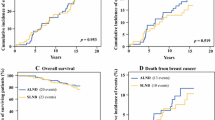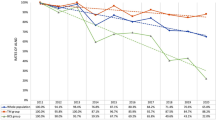Abstract
Background
The effect of axillary lymph node dissection (ALND) after sentinel lymph node biopsy (SLNB) in patients with clinically node-negative patients in preoperative evaluations on overall survival (OS) is uncertain. The study aimed to evaluate the difference of survival between node-positive patients who underwent SLNB alone and those who received ALND after SLNB using the Korean Breast Cancer Society registry.
Methods
We enrolled 2,581 patients who met the eligibility criteria. All enrolled patients had T1 or T2 breast cancer, and received mastectomy or breast-conserving treatment followed by documented adjuvant systemic therapy.
Results
There were 197 patients with SLNB alone and 2,384 patients with ALND after SLNB. Smaller tumor size, lower number of nodal metastasis, and higher proportion of breast-conserving surgery were found in patients with SLNB alone than in those with ALND after SLNB. There was no significant difference in OS between the two groups by the log-rank test. ALND after SLNB showed no significant improvement in OS in multivariate analysis.
Conclusions
ALND in patients with sentinel metastasis who have T1 or T2 breast cancer receiving adjuvant systemic therapy may not have improved OS.


Similar content being viewed by others
References
National Institutes of Health (NIH). NIH consensus conference. Treatment of early-stage breast cancer. JAMA. 1991;265:391–5.
Early Breast Cancer Trialists’ Collaborative Group (EBCTCG). Effects of chemotherapy and hormonal therapy for early breast cancer on recurrence and 15-year survival: an overview of the randomised trials. Lancet. 2005;365:1687–717.
National Comprehensive Cancer Network (NCCN). NCCN clinical practice guidelines in oncology breast cancer. 2011. http://www.nccn.org/professionals/physician_gls/pdf/breast.pdf. Accessed June 2011, 2011.
McLaughlin SA, Wright MJ, Morris KT, et al. Prevalence of lymphedema in women with breast cancer 5 years after sentinel lymph node biopsy or axillary dissection: objective measurements. J Clin Oncol. 2008;26:5213–9.
Grube BJ, Giuliano AE. Observation of the breast cancer patient with a tumor-positive sentinel node: implications of the ACOSOG Z0011 trial. Semin Surg Oncol. 2001;20:230–7.
Giuliano AE, McCall L, Beitsch P, et al. Locoregional recurrence after sentinel lymph node dissection with or without axillary dissection in patients with sentinel lymph node metastases: the American College of Surgeons Oncology Group Z0011 randomized trial. Ann Surg. 2010;252:426–32.
Giuliano AE, Hunt KK, Ballman KV, et al. Axillary dissection vs no axillary dissection in women with invasive breast cancer and sentinel node metastasis: a randomized clinical trial. JAMA. 2011;305:569–75.
American Joint Committee on Cancer (AJCC). AJCC cancer staging manual. 7th ed. New York: Springer; 2010.
Ahn SH, Son BH, Kim SW, et al. Poor outcome of hormone receptor-positive breast cancer at very young age is due to tamoxifen resistance: nationwide survival data in Korea: a report from the Korean Breast Cancer Society. J Clin Oncol. 2007;25:2360–8.
Shin HR, Won YJ, Jung KW, et al. Nationwide cancer incidence in Korea, 1999–2001; first result using the national cancer incidence database. Cancer Res Treat. 2005;37:325–31.
Moon HG, Han W, Noh DY. Comparable survival between pN0 breast cancer patients undergoing sentinel node biopsy and extensive axillary dissection: a report from the Korean Breast Cancer Society. J Clin Oncol. 2010;28:1692–9.
Wright PA, Zenilman ME. Less may be better: axillary dissection is unnecessary in some patients with a positive sentinel lymph node. Arch Surg. 2011;146:980–2.
Zoras O, Ziogas D, Roukos DH. Omitting axilla lymphadenectomy even by positive sentinel lymph node: a change in breast cancer treatment practice. Womens Health (Lond Engl). 2011;7:417–8.
Carlson GW, Wood WC. Management of axillary lymph node metastasis in breast cancer: making progress. JAMA. 2011;305:606–7.
Yi M, Giordano SH, Meric-Bernstam F, et al. Trends in and outcomes from sentinel lymph node biopsy (SLNB) alone vs SLNB with axillary lymph node dissection for node-positive breast cancer patients: experience from the SEER database. Ann Surg Oncol. 2010;17:343–51.
Bilimoria KY, Bentrem DJ, Hansen NM, et al. Comparison of sentinel lymph node biopsy alone and completion axillary lymph node dissection for node-positive breast cancer. J Clin Oncol. 2009;27:2946–53.
Caudle AS, Hunt KK, Kuerer HM, et al. Multidisciplinary considerations in the implementation of the findings from the American College of Surgeons Oncology Group (ACOSOG) Z0011 study: a practice-changing trial. Ann Surg Oncol. 2011;18:2407–12.
Gainer SM, Hunt KK, Beitsch P, Caudle AS, Mittendorf EA, Lucci A. Changing behavior in clinical practice in response to the ACOSOG Z0011 trial: a survey of the American Society of Breast Surgeons. Ann Surg Oncol. 2012;19:3152–8.
Guth U, Myrick ME, Viehl CT, Schmid SM, Obermann EC, Weber WP. The post ACOSOG Z0011 era: does our new understanding of breast cancer really change clinical practice? Eur J Surg Oncol. 2012;38:645–50.
National Comprehensive Cancer Network (NCCN). NCCN clinical practice guidelines in oncology breast cancer. 2013. http://www.nccn.org/professionals/physician_gls/pdf/breast.pdf. Accessed 17 Aug 2013.
Rutgers EJ, Donker M, Straver ME, et al. Radiotherapy or surgery of the axilla after a positive sentinel node in breast cancer patients: final analysis of the EORTC AMAROS trial (10981/22023). J Clin Oncol. 2013;31:abstr LBA1001.
Fisher B, Jeong JH, Anderson S, Bryant J, Fisher ER, Wolmark N. Twenty-five-year follow-up of a randomized trial comparing radical mastectomy, total mastectomy, and total mastectomy followed by irradiation. N Engl J Med. 2002;347:567–75.
Toussaint A, Nogaret JM, Veys I, et al. Axillary recurrence rate in breast cancer patients with negative sentinel lymph node biopsy or containing micrometastases and without further lymphadenectomy: a monocentric review of 8 years and 481 cases. Breast J. 2011;17:337–42.
Meretoja TJ, Vironen JH, Heikkila PS, Leidenius MH. Outcome of selected breast cancer patients with micrometastasis or isolated tumor cells in sentinel node biopsy and no completion axillary lymph node dissection. J Surg Oncol. 2010;102:215–9.
Langer I, Marti WR, Guller U, et al. Axillary recurrence rate in breast cancer patients with negative sentinel lymph node (SLN) or SLN micrometastases: prospective analysis of 150 patients after SLN biopsy. Ann Surg. 2005;241:152–8.
Van Zee KJ, Manasseh DM, Bevilacqua JL, et al. A nomogram for predicting the likelihood of additional nodal metastases in breast cancer patients with a positive sentinel node biopsy. Ann Surg Oncol. 2003;10:1140–51.
Yegiyants S, Romero LM, Haigh PI, DiFronzo LA. Completion axillary lymph node dissection not required for regional control in patients with breast cancer who have micrometastases in a sentinel node. Arch Surg. 2010;145:564–9.
Rescigno J, Zampell JC, Axelrod D. Patterns of axillary surgical care for breast cancer in the era of sentinel lymph node biopsy. Ann Surg Oncol. 2009;16:687–96.
Disclosure
The authors declare no conflict of interest.
Author information
Authors and Affiliations
Consortia
Corresponding author
Rights and permissions
About this article
Cite this article
Park, H.S., Chae, B.J., Song, B.J. et al. Effect of Axillary Lymph Node Dissection after Sentinel Lymph Node Biopsy on Overall Survival in Patients with T1 or T2 Node-positive Breast Cancer: Report from the Korean Breast Cancer Society. Ann Surg Oncol 21, 1231–1236 (2014). https://doi.org/10.1245/s10434-013-3350-6
Received:
Published:
Issue Date:
DOI: https://doi.org/10.1245/s10434-013-3350-6




